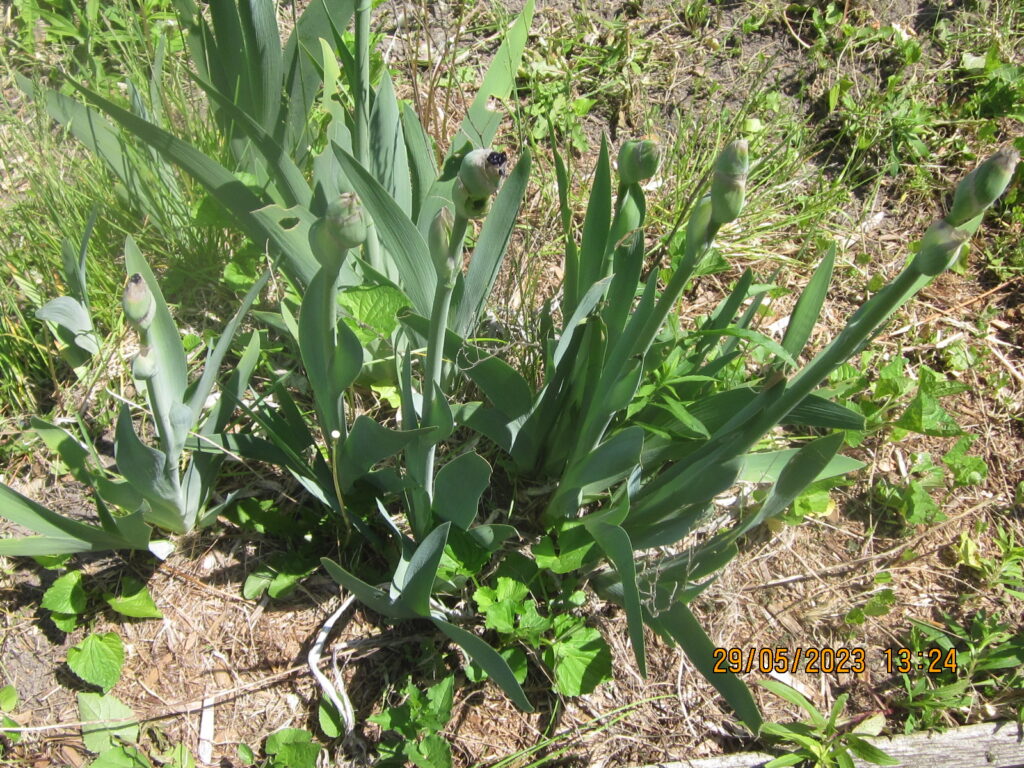
I’d delayed transplanting these irises which weren’t blooming
but they look better now, after years. Is the soil health the determinant of blooming?
Several issues can affect blooming. You indicate that it’s been a few years since your irises have bloomed –irises need to be divided and transplanted regularly – every 3-5 years or so. When plants are overcrowded, you’ll often see decreased blooming – a strong hint that it’s time to transplant. Your plants look quite close together, so this may be the issue. Overcrowding can also occur when irises are too close to other plants. The iris rhizomes (root structures) may even push out of the ground – another sign that transplanting is overdue.
Other conditions may affect blooming. Although most of these likely do not relate to your plants, they are worth mentioning:
- Shade. Neighbouring plants may have grown and now shade the irises (which need full sun, at least 6 hours of sunlight daily).
- Water. If the irises did not receive enough water in late winter/early spring or over an extended period – that too could prevent blooming.
- Fertilizer. As your irises have been in the same spot for years, if you have not added soil amendments, the soil may be depleted of nutrients. Be sure to avoid fertilizers that are high in nitrogen, as this promotes leaf growth – not blooms.
- Soil. You asked specifically about soils. Irises like well-draining soils – if you have clay soil, add compost and well-rotted manure to the soil before transplanting. If soil has compacted over the years, this could impact the plants’ performance. While soil health is important, it is not the sole determinant with respect to blooming – several other factors may contribute.
- Rhizomes planted too deeply. Although your irises have bloomed in the past, when transplanting, make sure the tops of the rhizomes are at or just slightly below the surface of the soil. Plant them too deep and the plants may grow lots of leaves, but no flowers.
- Mulch. Do not cover the iris rhizomes with mulch.
- Weeds. Aggressive weeds or grasses can compete with other plants, including irises. Keep the area well-weeded.
- Diseases/pests. Diseases or insects can afflict irises – this does not seem to be an issue with your plants.
- Freezes. If there is a freeze within a couple of months of the usual bloom time – this can kill developing stalks and the plants won’t bloom.
- Some irises bloom every few years. Not all irises bloom each year. Some cultivars may not be happy in your garden – give them 2-3 years to become established and replace them if they are reluctant bloomers.
The ideal time to transplant iris is after blooming, usually mid-July or August, or you can wait until the fall. It’s now end-May, it’s best to wait to see if your irises will indeed bloom. If not, divide and conquer… And if they do bloom, the advice is the same – time to transplant!
Lift the iris clump out of the soil (try to lift the entire clump at once or break it carefully into smaller portions). Clean dirt from the rhizomes then divide the rhizomes into pieces around 8-10 cm (4-5 inches) in length, and each piece should contain at least one set (fan) of leaves. Throw away any rhizomes that don’t have leaf fans or look unhealthy. Do not take the roots off the rhizomes. Make sure all the rhizomes are firm – if they are soft, this could indicate disease.
Cut back the leaf fans to 15-20 cm (6-8 inches) and plant in the desired spot, just beneath ground level. If your soil has indeed compacted over the years, amend the soil with compost and add fresh soil. Spread the roots out and cover both rhizome and roots with dirt. Plant the rhizomes 30-60 cm (12-24 inches) apart, firming the soil around each one. Water well. This should be a full sun location and in an area where the soil drains well. Note that if you plant smaller rhizomes, these may need to grow before they can bloom – this may take another season.
K-State Research & Extension’s Summer is the Best Time to Plant, Move or Divide Iris provides an excellent how-to divide/transplant irises.
All the best in getting your irises to bloom!

